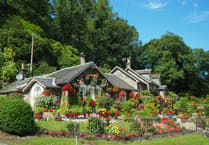Petersfield Heath has a history of human use that stretches back almost 10,000 years.
It is the site of a Stone Age hunter gatherer’s campsite, a Bronze Age cemetery, common ground for cattle grazing and peat cutting, recreation by walkers, golfers, tennis players and much more.
It is also the source of one of Petersfield’s longest-running feuds, between the Jolliffes of Petersfield and the Gibbons of Buriton.
At the start of the 18th century there was no pond on the heath; it was a peat moor where commoners could graze their cattle and cut peat for fuel.
It gradually became a bog in which cattle drowned, so in 1735 the people of the manor of Petersfield and of Mapledurham – the manor containing Buriton and Weston – created a pond to drain the land surrounding it. Both manors were owned by the Gibbon family at this time.
In 1739 Edward Gibbon II sold the manor and borough of Petersfield to John Jolliffe; the boundary between the now separate manors ran straight through the centre of the pond.
A boundary line over water is difficult to mark and control and in 1752 a dispute erupted over ownership of common land near to what is now Sussex Road.
On March 30, 1753, the dispute was heard in London. John Jolliffe sent a ‘waggon’ full of witnesses from Petersfield to testify to the location of the boundary across the pond, and an agreement was signed between the parties.
One half of the pond, it was agreed, was Gibbon’s property and the other half Jolliffe’s. The boundary divided the pond into two equal parts, from a point east of Horn Lane – Heath Road – to a point west of the Matthew’s House, where houses in Russell Way are now. Two boundary stones were put up to mark the boundary line across the pond.
But boundary clarification did not end the dispute between the Jolliffe and Gibbon families – it continued into the next generation. In 1775 John Jolliffe’s eldest son, William, brought an action against two commoners from Buriton, George Bone and Thomas Dedman, for trespassing and fishing in the Jolliffes’ half and not the Gibbons’ side.
It was claimed they took ‘2,000 tench, 1,000 trout, 1,000 graylings, 1,000 roach, 1,000 jacks, 1,000 perch, 1,000 carp and 1,000 eels’ from Jolliffe’s waters.
During the case at the Court of Common Pleas, it was found the boundary markers had been removed and the defendants, who seemed to not know there were two owners, would have been unable to ensure they fished only in the correct half.
When reading court records available from the Hylton Papers at the Somerset Records Office the details sound ridiculous, and it is thought it was brought up only as a way for William Jolliffe to annoy and frustrate the Gibbon family.
We do not know the outcome and the repercussions for the defendants, but it is thought that because of the outlandish nature of the claims about how many fish were taken, the judge would have been very lenient if they were found guilty.
This bizarre case captured the imaginations of Mary Ray, Winifred Turner and Marjorie Lunt, who turned it into a play performed by the Petersfield Area Historical Society in 1988. We have recently rediscovered the script and hope to put on a repeat performance in the future.




